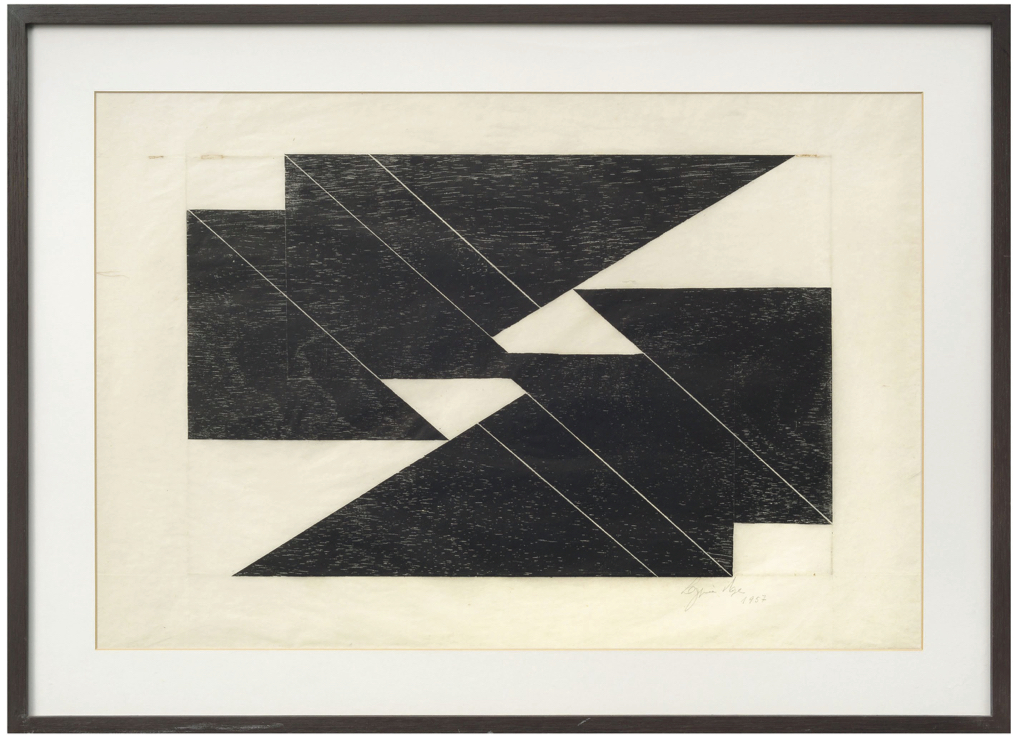Lygia Pape studied at the Museu de Arte Moderna in Rio de Janeiro. In 1953 she participated in the Exposio Nacional de Arte Abstrata (Hotel Quitandinha, Petrpolis, Brazil) and, in 1954, she co-founded the Grupo Frente which gathered Rio de Janeiro’s abstract-geometric artists around the figure of Ivan Serpa. Between 1955 and 1959 Pape created the series Tecelares (xylographs), which consisted of geometric forms engraved by hand allowing the wood’s texture to appear in the print. She participated in the Exposio Nacional de Arte Concreta (Museo de Arte Moderna, So Paulo, 1956; Ministerio de Educao e Cultura, Rio de Janeiro, 1957), contrasting the work produced by Frente and the So Paulo group Ruptura which held an extremely rationalistic position.
In 1957 Pape created Livro poema, a pioneering experience that actively involved the spectator who was required to manipulate the piece to achieve the effect of the art work. Her investigation of the human body as activator of art continued in 1958 with the presentation of Bal neoconcreto I at the Teatro Copacabana (Rio de Janeiro), in which, great cylinders and parallelepipeds were moved by dancers hidden inside them. In 1959 she signed the Manifiesto neoconcreto together with several ex- members of Grupo Frente and the critic and poet Ferreira Gullar, marking the official beginning of Neoconcretismo. Between 1959 and 1961 she made new art books: El livro da criaao, the Livro da arquitetura and Livro do tempo. In 1963 she experimented with film and joined the movement of Cinema Novo, and worked on drawing and sculpture. Her work involving audience participation continued with Roda dos prazeres (1967), Divisor (1968) and Ovo (as part of the collective manifestation Apocalipoptese, Aterro do Flamengo, Rio de Janeiro, 1968).
From 1975, her first one-person exhibitions indicated the main directions of her production. Facas de luz (Universidade Santa rsula, Rio de Janeiro, 1975), used light as protagonist, and Eat Me – A gula ou a luxuria? (Museu de Arte Moderna, Rio de Janeiro, 1975; Galera ArteGlobal, So Paulo, 1976) showed women as objects of consumption. The subject of light found its development in the series Tteia, a project of nets between trees for childrens’ play from which evolved complex installations of threads and lights, begun in 1977. Social and political themes were treated in installations such as Ovos do vento (1979) and films. During the 1980s she continued to produce a wide range of sculptures and paintings and in 1988 a retrospective exhibition of her neoconcrete stage was presented at Thomas Cohn Arte Contempornea (Rio de Janeiro).
Pape was a prolific printmaker. She argued that the woodblock print, in particular, was aligned with the aims of Neoconcreto, because of its inherent formal qualities. She made clear, however, that the choice of medium was more significant than this, saying, “In contrast to what one supposes, in Concretism, it is not indifferent to make prints, paintings or drawings. If an artist proposes a graphic problem, he will realize it in a print.”
